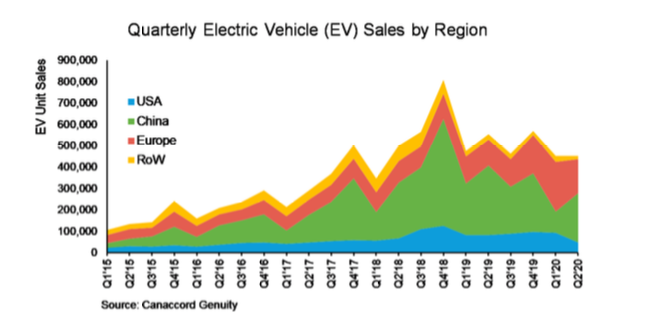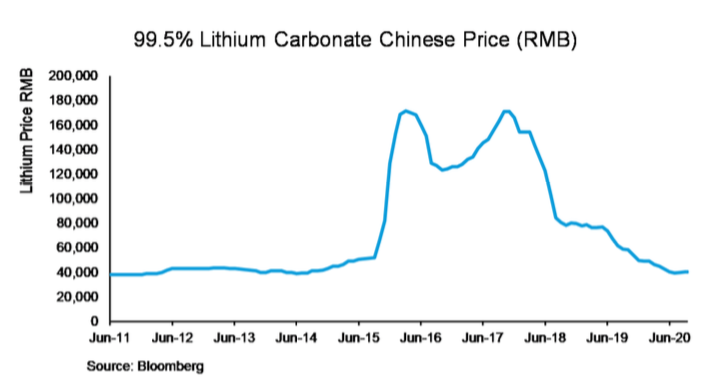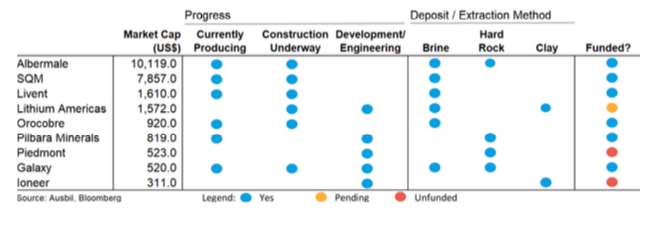Why we're bullish on lithium
This quarter we wanted to focus on the significant medium-term opportunity around raw materials for Electric Vehicles (EVs), and particularly Lithium, where we have recently pivoted our stance on the commodity and increased the Ausbil Investment Management Global Resources Fund positioning significantly.
We believe the inflection point for EV acceptance is nearing, and there are a number of implications for natural resources markets driven by this theme. The main winners (in terms of commodity volume growth) from an increase in global rechargeable battery demand are likely to be Lithium, Nickel and Cobalt, and potentially Manganese.
At a high level in terms of commodity exposures, pure-play cobalt exposures are hard to find globally, and so we see limited opportunities to invest in this segment in size. Graphite remains challenged, as costs of synthetic Graphite remain low, cannibalising the market for natural Graphite. We are paying attention to this space as opportunities may present, but broadly we believe a recovery in Graphite is likely to take some time because of increased synthetic Graphite capacity in China, and low Synthetic Graphite feedback prices (pet coke prices are low, reducing synthetic Graphite prices).
The Nickel market is currently dominated by Stainless Steel demand. In time, the proportion of Nickel consumed in Batteries will increase, and we are focused on this metal on a longer-term basis, but short-term we believe the best opportunity to leverage the EV thematic is through Lithium exposure.
China no longer dominates EV demand
One important theme we have seen play out over the past 18-months has been an increase in EV demand from countries outside of China. China has dominated global EV demand since 2017, supported by domestic subsidies, but as we have seen the EV market mature, other jurisdictions have seen an increase in EV demand. In Europe particularly, local subsidies now have a number of EV models at the same, or lower price point to internal combustion models. Where historically buyers were required to pay a premium upfront for an EV, offset by lower running costs longer-term, subsidies and reduced manufacturing costs, and now upfront prices are similar relative to internal combustion models.
On a long term basis, we believe reduced manufacturing costs for EVs (particularly batteries), and higher compliance costs for internal combustion engine vehicles will see the economic benefits move further towards EVs. This, combined with higher quality vehicles being available to the mass market, will continue to drive EV demand within China and other markets.

Supply has not eventuated in the Lithium market
Looking back at our own supply forecasts for Lithium from December 2018, production is well below where we expected. In part, this has been driven by supply curtailments as a result of weak pricing, but supply has not eventuated as we expected.
Lithium projects take time to fund, build, and commission. Even given the current excess production capacity in the market, we expect demand growth will absorb this excess capacity relatively quickly. With delays in new project construction, we could see a market reminiscent of 2017, where EV and battery makers scramble for product as the market tightens, driving commodity and equity markets higher.

Lithium prices appear to have bottomed
True pricing for Lithium products is difficult to locate in real-time, however Chinese pricing for Lithium Carbonate is shown below. Anecdotally Lithium producers are suggesting pricing has increased slightly in recent weeks and months, and demand from customers has stabilised and is increasing. Ultimately, we believe an increase in the Lithium price will see a re-rate in Lithium equities, however, given the nature of the market we believe equities will likely rally well ahead of reported price increases in the commodity market. As such, we have positioned the Fund long in Lithium, leading into expected price increases in Q4 CY2020 and Q1 CY2021.

How Lithium is produced
Broadly speaking, there are three common resources used to produce Lithium, Brine Deposits, Hard Rock Deposits and Clay.
Brine Deposits. Mainly focussed in South America (Chile/Argentina), Brine Deposits have been a source of Lithium for many years, with brine pumped to the surface, and Lithium extracted via a chemical process. Historically, brine has been concentrated, then a precipitation process used to purify Lithium into Lithium Carbonate, but more recent technologies are advancing for direct extraction of Lithium from brine. Examples of companies producing Lithium from Brine include Orocobre, SQM and Albermale.
Hard Rock Deposits. Hard Rock (typically Spodumene) deposits are common in Australia. The mining and processing route is similar to traditional mining practices (drill, blast and mine) and processing (crush, grind and separate). Spodumene projects produce a concentrate product which then needs to be upgraded to Lithium Carbonate or Lithium Hydroxide through a conversion facility. Projects can be integrated (where a miner also converts at their own processing plant), or a Spodumene concentrate market exists, where producers sell Spodumene concentrate rather than purified Lithium carbonate and Hydroxide. Examples of companies producing Lithium from Hard Rock Deposits include Galaxy Resources and Pilbara Minerals.
Clay. Tesla recently attracted attention to the Lithium space with Elon Musk suggesting Tesla may be able to produce their own Lithium from Tesla owned Clay deposits in the US. We remain a little cautious on Clay deposits, as traditional processing routes require high capex, albeit Musk suggested Tesla may have an alternate processing route. Examples of other companies assessing Lithium from Clay include Ioneer and Lithium Americas, however there are currently no producing clay Lithium deposits of which we are aware.
Our preferred plays in Lithium
Although there are a number of Lithium explorers globally, the list below shows our core focus list in the commodity. We believe there is currently a divergence in valuations between existing producers and developers, and the Fund currently holds positions in Galaxy Resources, Orocobre and Pilbara Minerals.

Invest in high quality natural resources companies
The Ausbil Global Resources team looks to capitalise on the volatility within the natural resources sector by employing a long/short approach to global natural resources equity markets with a focus on generating positive returns in both rising and falling commodity markets. Click 'FOLLOW' for more of our insights.
3 topics
5 stocks mentioned
1 contributor mentioned

